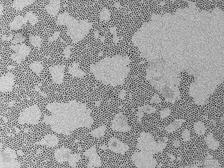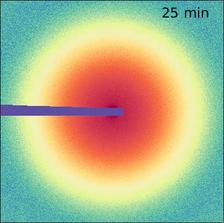Electron micrograph of unordered lead sulfide nanocrystals. (Credit: DESY, Irina Lokteva)
Using X-rays, a DESY research team has watched live how nanocrystals organise themselves into a highly ordered layer. The study helps to better understand the self-organisation of nanoparticles, which is important for many technical applications, for example in electronics and optoelectronics, as the scientists write in the journal Small.
Nanocrystals are known to form ordered structures, for example during the controlled evaporation of a solvent. These so-called superstructures can develop completely new material properties through the interaction of the many individual crystals. “However, the result of this self-organisation of the crystals is difficult to predict and even more difficult to control,” explains DESY researcher Irina Lokteva, main author of the publication.
In order to better understand self-organisation, the scientists investigated lead sulfide nanocrystals as a model system. The individual crystals typically had a diameter of just under four nanometres (millionths of a millimetre). “Lead sulfide is used in solar cells, light-emitting diodes and transistors,” says Lokteva, who works in the DESY research group Coherent X-ray Scattering of Gerhard Grübel together with Felix Lehmkühler, both are co-authors of the study. To prevent the nanocrystals from sticking together during production, they were stabilised with oleic acid, which wraps around the particles - like e.g. gummy bears are waxed to prevent them from sticking together. Stabilisation with oleic acid is an established process in nanotechnology.
For the time-resolved investigations, the nanocrystals were suspended in the organic solvent heptane. The authors designed a specialized sample chamber that allows to fine tune the time range, which is needed for self-organisation. As the solvent evaporated slowly during about two hours, the scientists could watch how a 3D highly ordered layer of nanocrystals formed at the walls of the sample holder from the top to the bottom.
Experimenting at the European Synchrotron Radiation Facility ESRF in Grenoble (France), the scientists analysed the exact structure layer every three seconds with X-rays. It turned out that the nanocrystals were initially organised in a hexagonal close-packed (hcp) structure in the lead sulfide superstructures, which has not been reported so far . However, as soon as the solvent had completely evaporated, the layer changed abruptly into a body-centered cubic (bcc) structure.
This effect, which the team observed live for the first time, can either be used or avoided in order to produce layers with desired properties. “With the right framework conditions for self-organisation, the final structure can be influenced according to the requirements of the application,” explains Lokteva.
The observation of the lead sulfide model system also yields important insights into properties of other materials. Especially for many applications of nanoparticles ordered films are required. The research results are a step towards better understanding both the self-organisation of nanoparticles and the interaction of the oleic acid ligands with the organic solvent heptane. Based on these studies, the research team currently plans further studies on nanocrystal self-organisation at DESY’s light source PETRA III.
(from DESY news)
References:
Monitoring Nanocrystal Self-Assembly in Real Time Using In Situ Small-Angle X-Ray Scattering; Irina Lokteva, Michael Koof, Michael Walther, Gerhard Grübel und Felix Lehmkühler; Small, 2019; DOI: 10.1002/smll.201900438
In situ small-angle X-ray scattering environment for studying nanocrystal self-assembly upon controlled solvent evaporation; Irina Lokteva, Michael Koof, Michael Walther, Gerhard Grübel und Felix Lehmkühler; Review of Scientific Instruments 90, 036103 (2019); DOI:10.1063/1.5082685










